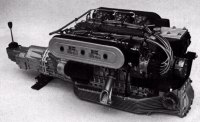

 |
 |
Stanzani originally wanted to increase the capacity to 5 litres to provide the power needed for 200 mph top speed. As publicised in the LP500 prototype in the 1971 Geneva show, the "imagined" V12 displaced 4,971 c.c. and was capable of as much as 440 hp. However, there were serious development problems (and perhaps limited by the budget) so that it was soon discarded. Instead, Miura's 3929c.c. unit was adopted, with some modifications of course.
The V12 was extremely "over-square" to boost power - 82 mm bore versus 62 mm stroke. Aluminium alloy head and block. Dohc per bank driving 2 valves per cylinder. Compression ratio was 10.5:1. Dry sump lubrication ... all these were the most spectacular specifications then. The peak power was 375 hp, occurred at sky-high 8,000 rpm if you believe Lamborghini's claim (usually less trustable). Peak torque was 268 lbft at 5,000 rpm. Don't think it must be very peaky, in fact road testers praised its good manner. We are going to see that in Chapter VI.
Unlike Miura, the V12 was positioned in north-south direction for better cooling. The transmission, now no longer incorporated with the engine sump, was mounted in front of the engine for better weight distribution.
Nevertheless, there were some drawbacks. The output from the gearbox was transmitted back to the rear axle via a drive shaft locating underneath the engine, inside the sump. Inevitably, the engine had to be raised for a few inches to accommodate the drive shaft. As a result, center of gravity was raised, too.
As the engine sat higher, to compensate the loss of rear vision, the carburettors were repositioned to horizontal, hence less ideal breathing and 10 horsepower loss compared with Miura SV.

At the time when carbon fiber was not yet invented, Countach undoubtedly did everything to save weight.
 In order to enhance stability in high speed cornering, the body was made
wide and low. Wider body did not reflect in cabin room, because the space
frames created a wide sill between the door and the seat. Ultra-low body
was achieved by installing the thin seats directly to the floor, though
I suspect its effectiveness in lowering the overall centre of gravity.
It couldn't help much the drag too, because any reduction in frontal area
was nothing compared with the awful drag coefficient in-excess of 0.40.
In order to enhance stability in high speed cornering, the body was made
wide and low. Wider body did not reflect in cabin room, because the space
frames created a wide sill between the door and the seat. Ultra-low body
was achieved by installing the thin seats directly to the floor, though
I suspect its effectiveness in lowering the overall centre of gravity.
It couldn't help much the drag too, because any reduction in frontal area
was nothing compared with the awful drag coefficient in-excess of 0.40.
As expected for a supercar, Countach employed unequal-length double wishbones suspensions in all corners.